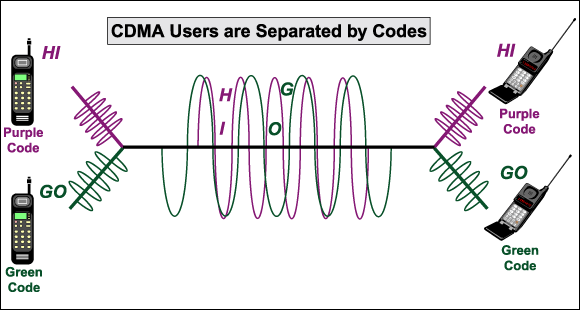| << Chapter < Page | Chapter >> Page > |
Code division multiple access, or CDMA, is a channel access method often used in radio/cell phone communication. CDMA employs the spread-spectrum modulation format, which has the advantage of making the signals resistant to narrowband interference, since it would only affect a small portion of the spread spectrum signal it is easy to filter out without a significant loss of data, difficult to intercept and resistant to jamming.

Direct-sequence spread spectrum for CDMA involves multiplying the data to be transmitted by a pseudo-random sequence of -1’s and 1’s. This spreads the original signal into a much wider band, hence the term “spread-spectrum.” The original data can be restored by the receiver using a de-spreading technique. This involves de-spreading the received signal with the pseudo-random sequence respective to the original signal. To do this, the transmitted and received sequences must be synchronized.
CDMA uses orthogonal coding to allow multiple users to access a channel simultaneously. An advantage of CDMA is that it is possible to keep increasing the number of users for a system. In comparison, other techniques for multiple access, such as frequency and time division, rely on assigning a specific frequency or time slot to each user. This greatly limits the efficiency of a system, since the number of frequencies available for wireless communication is limited, and the use of time division only allows for one user to access the channel at a time. Essentially FDMA and TDMA set hard limits on the number of users a system can have because there is no way to continue making divisions past a certain point. On the other hand, with CDMA it is possible to keep adding users. The limiting factor of CDMA is the error rate, which increases with each added user.
For our model we assume that we know when the signal arrives at the transmitter, so we can assume that the modulation and de-modulation codes are synchronized. Each user has a pseudo-random noise (PN) sequence that is orthogonal to other users’ PN sequences. Their cross-correlation is close to 0. The orthogonality of the codes ensures that each signal’s transmitter-receiver pair will only deal with its corresponding signal; in other words, the receiver for a particular signal will see any other signal going through the channel as simply noise, and this will eliminate multiple-access interference.
In direct sequence spread spectrum, there are two types of spreading sequences: short and long. In short spreading sequences, the spreading sequence is periodic with a period equal to the processing gain. As a result, the same short sequence is used to modulate each symbol which is transmitted. Examples of short spreading sequences are Walsh Codes and Gold Codes. In long spreading sequences, the spreading sequence is either aperiodic or has a period which is much longer than the processing gain. We chose to use long spreading sequences in our model because long spreading sequences are used in the IS-95 standard. Long spreading PN sequences can be generated using maximum length shift registers. To acquire sequences for each user which are close to mutually orthogonal, each user is assigned a shifted version of the PN sequence.

Notification Switch
Would you like to follow the 'Elec 301 projects fall 2011' conversation and receive update notifications?